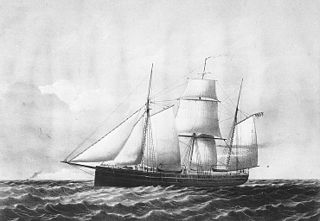
USS Minnesota was a wooden steam frigate in the United States Navy. Launched in 1855 and commissioned eighteen months later, the ship served in east Asia for two years before being decommissioned. She was recommissioned at the outbreak of the American Civil War and returned to service as the flagship of the North Atlantic Blockading Squadron.
Princess Royal was a British merchant ship and blockade runner that became a cruiser in the Union Navy during the American Civil War and later returned to civilian service.

The first USSSassacus, a wooden, double-ended, side-wheel steamer, was launched on 23 December 1862 by the Portsmouth Navy Yard in Kittery, Maine, sponsored by Miss Wilhelmina G. Lambert. Sassacus was commissioned at the Boston Navy Yard on 5 October 1863, Lieutenant Commander Francis A. Roe in command.

USS South Carolina (1860) was a steamer used by the Union Navy during the American Civil War.

USS Stars and Stripes (1861) was a 407-ton steamer acquired by the U.S. Navy and put to use by the Union during the American Civil War.

The second USS Louisiana was a propeller-driven iron hull steamer in the United States Navy during the American Civil War.

USS Niphon was a steam operated vessel acquired by the Union Navy during the American Civil War. She was used by the Navy to patrol navigable waterways of the Confederacy to prevent the South from trading with other countries.

USS Aries (1863) was an 820-ton iron screw steamer built at Sunderland, England, during 1861-1862, intended for employment as a blockade runner during the American Civil War. She was captured by Union Navy forces during the Union blockade of the Confederate States of America, and was commissioned as a Union gunboat. Aries was named for the constellation.
USS Stettin was a 600-ton iron screw steamship, was built at Sunderland, England, in 1861 and later served as a gunboat in the United States Navy during the American Civil War.
USS Howquah was a screw steamer purchased by the Union Navy in Boston from G. W. Upton on 17 June 1863, for action against Confederate commerce raider CSS Tacony which was then preying upon Northern merchantmen during what Professor Richard S. West has called "the most brilliant daredevil cruise of the war."
The USS Governor Buckingham was a hermaphrodite brig in the United States Navy during the American Civil War. The ship was built under contract by Messrs Maxon Fish & Co., Mystic, Conn., and was offered for sale to the Navy while on the ways; purchased at Stonington, Connecticut, 29 July 1863 by Isaac Henderson for $110,000; delivered at New York Navy Yard 30 September 1863; and commissioned 13 November 1863, Acting Volunteer Lt. W. G. Saltonstall in command. She was assigned to the North Atlantic Blockading Squadron, with instructions to report at Hampton Roads to Acting Rear Admiral S. P. Lee. The ship was probably named for the Governor of Connecticut, William Alfred Buckingham.

The USS Cherokee was a 606-ton screw steam gunboat in the US Navy during the American Civil War ship. The ship later served in the Chilean Navy.

USS General Putnam (1857) – also known as the USS William G. Putnam – was acquired by the Union Navy during the first year of the American Civil War and outfitted as a gunboat and assigned to the Union blockade of the Confederate States of America. She also served as a tugboat and as a ship's tender when so required.
USS Penobscot was a Unadilla-class gunboat built for the Union Navy during the American Civil War.
USS Nita (1856) was a captured Confederate steamer acquired by the Union Navy from the prize court during the American Civil War. She was put into service by the Union Navy to patrol navigable waterways of the Confederacy to prevent the South from trading with other countries.
USS Tristram Shandy (1864) was a 444-ton steamer and blockade runner captured by the Union Navy during the American Civil War.
USS Britannia (1862) was a steamer captured by the Union Navy during the American Civil War. She was used by the Union Navy as a gunboat and patrol vessel in support of the Union Navy blockade of Confederate waterways.
USS Victoria (1855) was a steamer acquired by the Union Navy during the American Civil War.
USS Violet (1862) was a 166-ton steamer acquired by the U.S. Navy for use during the American Civil War.

The blockade runners of the American Civil War were seagoing steam ships that were used to get through the Union blockade that extended some 3,500 miles (5,600 km) along the Atlantic and Gulf of Mexico coastlines and the lower Mississippi River. The Confederate states were largely without industrial capability and could not provide the quantity of arms and other supplies needed to fight against the industrial north. Blockade runners built in Scotland and England met this need and imported the guns, ordnance and other supplies that the Confederacy desperately needed, in exchange for cotton that the British textile industry likewise was in desperate need of. To get through the blockade, these ships, built in British ship yards and specially designed for speed, had to cruise undetected, usually at night, through the Union blockade. The typical blockade runners were privately owned vessels often operating with a letter of marque issued by the Confederate States of America. If spotted, the blockade runners would attempt to outmaneuver or simply outrun any Union ships on blockade patrol, very often successfully.









